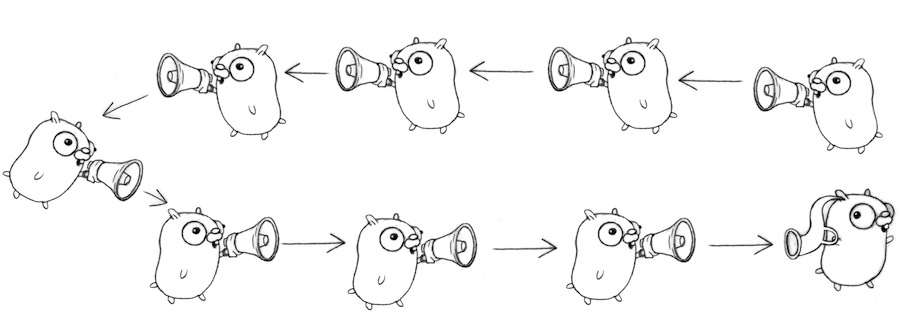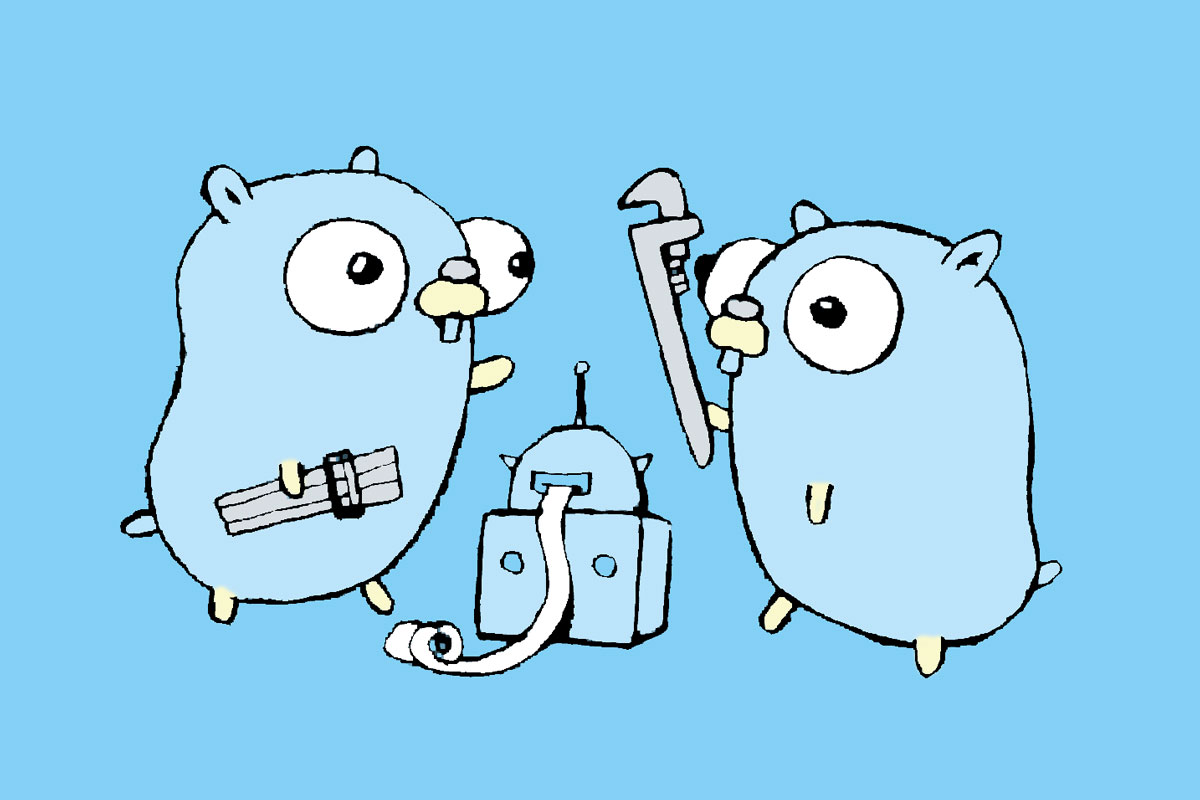Object Orientation in Go
What is Object Orientation anyway ?

Here I try to share my journey understanding how Go approaches object orientation and how in the end it seems much more object oriented than most “traditional” object oriented languages.
On a previous post I explored the idea of expressing everything just with functions, and that Go objects are actually just a safe way to express a set of functions that always go together with the same closure and may operate on same state.
Safely expressing sets of functions that operates on same state is pretty useful, but how to actually create abstractions that can have multiple different implementations ?
Objects alone do not support that, each type has its own set of functions attached to it (what we call methods) and that is it. This is referred as polymorphism, but as I walk away from the traditional notion of object orientation being about the objects and its form (type) I find that thinking about protocols instead of polymorphism is more aligned with what should be the focus when you are designing software (more on that later).
How to define a protocol ?
First lets define what would be a protocol, for me a protocol is a set of operations required to achieve a desired outcome.
If this seems confusing let me give an example with the easier to understand abstraction that I know, I/O.
Lets say you want to read a file, the protocol will be:
- Open file
- Read its contents
- Close it
To achieve your single purpose of reading all the contents of a file you need these 3 operations, so these operations are what forms your “reading file” protocol.
Now lets get this example and work with it through the rest of the post.
If functions are first class citizens in a language, structuring functions would not differ from structuring data.
We have a way to compose data (structs), we could compose the functions the same way, like this:
type Reader func(data []byte) (int, error)
type Closer func() error
type ReadCloser struct {
Read Reader
Close Closer
}
type Opener func() (*ReadCloser, error)
func useFileProtocol(open Opener) {
f, _ := open()
data := make([]byte, 50)
f.Read(data)
f.Close()
}
func main() {
useFileProtocol(func() (*ReadCloser, error) {
return &ReadCloser{}, nil
})
}
Which is very hard (if not impossible) to be a compile time safe way to express a protocol. To make a point this example causes a segmentation fault.
Another problem is that the code implementing the protocol needs to known the protocol it is implementing explicitly in order to initialize the struct properly (just as how it happens with inheritance), or delegate the struct initialization to other part of the system which would spread around the code the knowledge on how to initialize the struct properly. When you think about the same set of functions implementing multiple protocols this gets even worse.
The object that needs some third party protocol needs a way to:
- Express clearly what is the protocol it needs
- Be sure that when it starts interacting with an implementation no function is missing
The object that implements the service needs to:
- Be able to safely express that it has the required functions to satisfy the protocol
- Be able to satisfy a protocol even without knowing it explicitly
There is no need for two objects to interact to achieve a common goal to have a specific type, all that matters is if the protocol between them matches.
This is where Go interfaces comes in. It provides us with a compile time safe way to express protocols eliminating all the boilerplate of initializing structs with the proper functions. It will initialize the structs for us, and even optimize to initialize the struct just once, what is called in Go the iface, which is comparable to C++ vtable.
It will also allow the code to be more decoupled since you don’t have to known the package where the interface is defined to implement it. This is fundamental to how Go allows more flexibility with the same compile time safety as languages like Java/C++.
Lets revisit the previous file protocol with interfaces:
package main
type Reader interface {
Read(data []byte) (int, error)
}
type Closer interface {
Close() error
}
type ReadCloser interface {
Reader
Closer
}
type Opener func() (ReadCloser, error)
type File struct {}
func (f *File) Read(data []byte) (int, error) {
return 0, nil
}
func (f *File) Close() error {
return nil
}
func useFileProtocol(open Opener) {
f, _ := open()
data := make([]byte, 50)
f.Read(data)
f.Close()
}
func main() {
useFileProtocol(func() (ReadCloser, error) {
return &File{}, nil
})
}
One key difference is that with interfaces this code is now safe. The useFileProtocol do not have to worry with calling functions that are actually nil, the Go compiler will do the work of creating a struct that holds a pointer with a iface descriptor that has all the functions required to satisfy the protocol. It does this per match of type <-> interface, as it is used (initializes on first usage).
You still can cause a segmentation fault if you do something like this:
useFileProtocol(func() (ReadCloser, error) {
var a ReadCloser
return a, nil
})
But there is still the bonus that every time you initialize the variable properly, like this :
useFileProtocol(func() (ReadCloser, error) {
var a ReadCloser = &Whatever{}
return a, nil
})
If it compiles you can be sure it is safe to call all functions of the interface. Also with the Go’s interface mechanism an object can implement multiple different protocols without even knowing these protocols.
How useful can be implementing protocols that you do not even know it exists ? This is very useful if you want your code to be truly extensible. Allow me to provide a real world example from nash.
Extending code beyond its original purpose
The first time I understood how powerful Go interfaces can be was when I was trying to code the tests for the built-in function exit on nash. The main problem was that it seemed like we would have to implement different tests for each platform because the exit status code was handled differently on some platforms. I don’t remember all the details right now but on plan9 the exit status is an string instead of an integer.
Basically on an error I wanted the status code, not just the error like it is provided on Cmd.run.
There is the ExitError type, so I could do something like this:
if exiterr, ok := err.(*exec.ExitError); ok {
}
To at least know that this is some error generated by an error status on the process I just executed, but I was still out of luck on finding the actual status code.
So I went on a stroll inside Go’s code base to checkout how I could get the error status code from ExitError.
My clue was the ProcessState that is composed inside the ExitError struct, the Sys method seemed promissing:
// Sys returns system-dependent exit information about
// the process. Convert it to the appropriate underlying
// type, such as syscall.WaitStatus on Unix, to access its contents.
func (p *ProcessState) Sys() interface{} {
return p.sys()
}
Well, interface{} kinda says nothing, but following its threads I found this posix implementation:
func (p *ProcessState) sys() interface{} {
return p.status
}
And what would be p.status, on posix:
type WaitStatus uint32
With the very interesting method:
func (w WaitStatus) ExitStatus() int {
if !w.Exited() {
return -1
}
return int(w>>shift) & 0xFF
}
But this is for posix, what about other platforms ? Using this advanced inspection technique:
syscall % grep -R ExitStatus .
./syscall_nacl.go:func (w WaitStatus) ExitStatus() int { return 0 }
./syscall_bsd.go:func (w WaitStatus) ExitStatus() int {
./syscall_solaris.go:func (w WaitStatus) ExitStatus() int {
./syscall_linux.go:func (w WaitStatus) ExitStatus() int {
./syscall_windows.go:func (w WaitStatus) ExitStatus() int { return int(w.ExitCode) }
./syscall_plan9.go:func (w Waitmsg) ExitStatus() int {
Looks like common protocol being implemented by a good enough amount of platforms, it was good enough for me at least (windows + linux + plan9 would be enough). Now that we have a common protocol for all desired platforms we can do something like this:
// exitResult is a common interface implemented by
// all platforms.
type exitResult interface {
ExitStatus() int
}
if exiterr, ok := err.(*exec.ExitError); ok {
if status, ok := exiterr.Sys().(exitResult); ok {
got := status.ExitStatus()
if desc.result != got {
t.Fatalf("expected[%d] got[%d]", desc.result, got)
}
} else {
t.Fatal("exit result does not have a ExitStatus method")
}
}
The whole code can be found here
If the Sys() method returned an abstraction more precise than just interface{} it would be easier to come up with a new interface that is a subset of its interface and we would have compile time safety, instead of just runtime safety that is provided by the checked runtime cast.
But even an easy way to define a new interface and perform a safe runtime cast without changing the original code that implements the interface is pretty neat. In languages like Java or C++ I can’t come up with a solution that involves the same amount of code/complexity, specially because of the brittleness of hierarchy based polymorphism. Casting is only allowed if the original code knows the interface you are trying to cast and explicitly inherits from it. To solve my problem I would have to change the core Go code to know my interface, with Go interfaces this is not required (yay hierarchies).
This is extremely important because it allows developers to come up with simple objects since they don’t have to predict every single way that the object may be used on the future, like coming up with which interfaces may be useful.
As long as the protocol of your object is clear and useful it may be reused on several ways that you never thought to be possible. You don’t even need to express interfaces explicitly for them to be defined and used later.
What is object orientation anyway ?
This is the part where I will try to make a point for Go as an awesome object oriented language. All the early contact that I had with programming was with languages like:
- Java
- C++
- Python
And learned about inheritance, multiple inheritance, diamond inheritance, etc. There was a great focus on what are the types and inheritance trees, an exercise on taxonomy. Like creating a good taxonomy would be the definition of a good object oriented design.
As I progressed I started to talk with people who said that object orientation was not about that (although all mainstream object oriented languages were) and that way of designing was not flexible. I did not understand that at the time but it got me curious. The best chance of understanding something is going the closest to its core as possible, so I went for Alan Kay which is the one who coined the term object orientation.
There is much more awesome stuff that can be learned from him, but on the subject of object orientation there is the presentation The computer revolution has not happened yet at OOPSLA where he talks a little about the origin of object orientation (among other things).
He says that object orientation was supposed to focus on what is between the objects, not the objects itself. He even says that a more process oriented name would be better, because the focus on objects seems to have generated a focus on types and taxonomy instead of this thing that actually exists between the objects, which for me it is the protocols.
The important part of thinking about objects is the encapsulation (again, not types). He gives a good example which are cells, they have membranes that are explicit on what they allow to go out and what they allow to go in.
Every cell that interacts with each other knows nothing about each other inner workings, they don’t need to know the other cell type, they just have to implement the same protocol, exchange the same proteins, etc (I’m not that good with biology =)). The focus is on the chemical reactions (processes) not the cells types.
So we end up with encapsulation and clear protocols as what object orientation should be about, and with a great metaphor on how to develop systems that imitate organisms instead of mechanisms, since organic life scales orders of magnitude better.
Another great metaphor can be extracted from The Future of Programming presentation. When talking about the beginning of the ARPANET and the “Intergalactic Computer Network” one of the metaphors used to express how a system could REALLY scale is how software would integrate with other software that is completely alien (literally from other planet).
The metaphor is great because it shows the need for good protocols and good forms to do content/protocol negotiation, which is what happens on nature all the time, and probably what would happen if we met alien life someday (hoping that we don’t stupidly fight to death).
This metaphor even makes some point for dynamic languages, but to be honest I don’t have an understanding of this that is good enough to propose something right now (I find hard to think on something really adaptative without being dynamic, even in Go you need some glue code to integrate the objects through manually created protocols).
The most important take right now of this metaphor is not what would be best to represent this kind of system but to have the right mindset to find possible answers, quoting from the presentation:
The most dangerous thought that you can have as a creative person is to
think that you know what you are doing
Even though I try to keep an open mind I can’t find space for inheritance when I think about programming using the metaphors above. Alien life would never integrate since they need a common ancestor that may simply not exist.
Conclusion
The example that I gave above in Go already shows a glimpse on how you can do more without having to change any pre existent code using the concept of protocols (Go’s interfaces) instead of types. It seems to be easier to develop according to the open closed principle since I can easily extend other code to do things that it was not initially intended to without having to change it.
It may seem misleading that Go and Java have interfaces since the only thing they have in common is their name. In Java interfaces create a is a relationship, in Go it does not. It simply defines a protocol that can be used to integrate objects that don’t know each other directly (they don’t even have to know the interface explicitly).This seems more object oriented than anything that I know so far (not that I know too much of course =)).
Acknowledgments
Special thanks to:
For taking time reviewing and pointing out a lot of stupid mistakes.





Share this post
Twitter
Google+
Facebook
Reddit
LinkedIn
StumbleUpon
Pinterest
Email